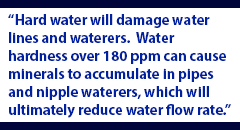
Water as a nutrient (part 2): Water quality impacts bottom line
 Editor’s note: This is the second article in a series about water and its impact on swine health and performance.
Editor’s note: This is the second article in a series about water and its impact on swine health and performance.
By Dr. Michaela Trudeau
Water is the most important nutrient to pigs, but it is frequently overlooked in swine management. Too frequently, as long as we know pigs have access to water, we don’t stop to consider whether the water source is of a quality that will improve – not hinder – pigs’ performance. Water is consumed at much higher quantities than other nutrients, so ensuring the water is safe and of good quality is critical. Below are different ways to evaluate water quality, ranging from a simple on-farm evaluation to more in-depth measurements.
- Physical evaluation: Smell and visually examine a water sample. The water should be clear and free of odor or discoloration. Also check water pressure and flow rate in each of the pens.
- Chemical evaluation: Submit a water sample to a laboratory to measure compounds present in the water sample. Some of these compounds create an unappetizing taste or smell, which decreases water intake. Other compounds, such as sulphates, cause diarrhea in young animals and reduce pig performance.
- Microbial evaluation: Measure the amount of bacteria in a water sample. Certain swine pathogens (see “coliforms” below) can form biofilms and accumulate in waterers.
Taking a sample for water quality analysis
For chemical and microbial evaluations, a water sample will need to be submitted to your preferred testing laboratory. Following the protocol below can help you obtain appropriate water quality samples.
- Sample on a “typical” day when no medication is in the waterlines.
- Wash your hands and obtain two clean, dry containers with a secure lid.
- Take one sample of water coming into the facility before any water treatment is applied. This should be done as close to the well as possible, commonly from the pressure tank, before water enters the barn.
- Clean the spigot before taking the water sample.
- Fill the container with water, being careful not to touch the container to the spigot or touch the inside or lip of the container with your hands.
- Take the second water sample from the exact location where the animals are drinking the water. Do not clean this area before sampling. It is very important to collect the sample directly from the trough, nipple waterer, or wet-dry feeder, as this will provide the most accurate snapshot of what the animals are consuming.
- Check with your testing lab on ideal storage conditions for the samples and their submission process based on the analysis being done. Use this process to submit samples to the testing lab.
Interpreting water quality measurements
Submitting a water sample for an assessment will help you evaluate the chemical and microbial parameters of your water sample, but interpreting those results can be challenging. Outlined below are common water quality parameters and their consequences on animal health.
- pH (6.5-8.5): Generally, the pH of water will not directly impact pig health. However, the pH can impact water medications or water treatment systems. For example, sulfonamide antimicrobials – such as sulfafurazole and sulfasomidine – can precipitate and stay in the water lines, which could later cause problems with carcass residues. Make sure you communicate with your veterinarian if you have a high or low water pH and are using a water medication. In addition to antimicrobial interactions, some water treatment plans, such as chlorination, will be less effective at an extreme pH.
- Total dissolved solids (less than 3,000 ppm): Interpreting a TDS measurement can be difficult because lots of contaminants can contribute to the TDS value. TDS values greater than 3,000 ppm can cause mild diarrhea in pigs. As the TDS value increases, water flavor will be altered and water intake will decrease.
 Hardness (60-180 ppm): Like pH, water hardness will not directly impact pig health. Instead, hard water will damage water lines and waterers. Water hardness over 180 ppm can cause minerals to accumulate in pipes and in nipple waterers, which will ultimately reduce water flow rate.
Hardness (60-180 ppm): Like pH, water hardness will not directly impact pig health. Instead, hard water will damage water lines and waterers. Water hardness over 180 ppm can cause minerals to accumulate in pipes and in nipple waterers, which will ultimately reduce water flow rate.- Sulfates (less than 1,000 ppm): When present at very high levels (greater than 7,000 ppm), sulfates cause diarrhea and reduce pig growth. When present at levels greater than 1,000 ppm, sulfates will not impair health, but their odor and off flavor reduce water intake.
- Nitrates and nitrites (less than 100 ppm): Water nitrates can be of concern if there is heavy field application of fertilizers and water contamination through runoff. Nitrates in the water can reduce the pig’s ability to transport oxygen in the blood, causing low oxygenation of tissues and difficulty breathing. When contamination reaches 300 ppm, mortality will increase.
- Coliforms (less than 50 CFU/mL): The measurement of coliforms indicates the number of bacteria present in the water sample, though it will not indicate which type of bacteria is present. Certain swine pathogens, including E. coli, Salmonella spp., Listeria monocytogenes, Mycobacteria spp., Staphlococcuss aureus, and some enteroviruses, can form biofilms and accumulate in waterers. These biofilms are an accumulation of bacteria protected by proteins the bacteria create and, if not cleaned, they can disrupt water flow or spread pathogens to animals.
Although pigs are generally tolerant of poor water quality, understanding how your farm’s water impacts pig health, water intake or building maintenance can help you improve your bottom line. Speak with you Vita Plus nutritionist if you are interested in evaluating water quality on your farm.
About the author: Dr. Michaela Trudeau joined Vita Plus as a swine nutritionist in 2020. She grew up in Minnesota and attended the University of Minnesota to receive her bachelor’s degree in animal science with honors. Trudeau continued her education at the University of Minnesota and received a master’s degree in animal science. Her master’s thesis focused on the persistence of porcine coronaviruses in feed and feed ingredients. In December 2020, Trudeau received her Ph.D. in animal science at the University of Minnesota, where her research focused on understanding the mechanisms of growth responses to various antibiotic alternatives in nursery pigs.
| Category: |
Animal health Feed quality and nutrition Swine Performance |

